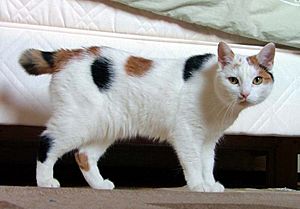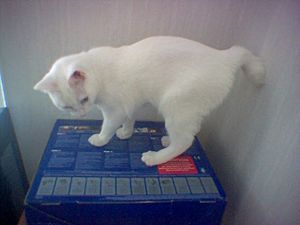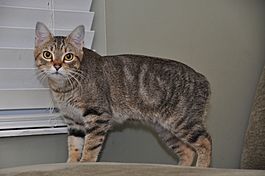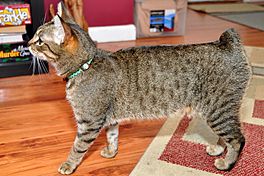Manx (cat) facts for kids
The Manx is a special kind of domestic cat. It comes from the Isle of Man, a small island between Great Britain and Ireland. What makes Manx cats unique is their tail, or often, the lack of one! Some Manx cats have no tail at all, which is called a "rumpy." Others have a very short tail, known as a "stumpy." This happens because of a natural difference in their spine length. Manx cats also have back legs that are longer than their front legs. They are known for being good hunters.
Contents
Appearance of Manx Cats
Tail Types
The most famous thing about the Manx cat is its tail, or rather, how short it can be! This is caused by a natural change in their spine, due to a dominant gene. This means that if a kitten gets this gene from even one parent, it might have a short or no tail.
Manx cats can have different tail lengths, even in the same litter of kittens. Here are the main types:
- Rumpy (or dimple rumpy): These cats have no tail at all. They might just have a small tuft of hair where the tail should be.
- Riser (or rumpy riser): These cats have a tiny bump of cartilage under their fur where a tail would start. You can often feel it when they are happy.
- Stumpy (or stumpie): These cats have a short tail, usually about 3 cm (1 in) long. It's made of a few fused vertebrae (spine bones).
- Stubby (or shorty): These cats have a short tail that is about half the length of a normal cat's tail. Their tail bones are not fused.
- Longy (or taily): These cats have a tail that is half to full length, like a regular cat.
For cat shows, usually only rumpy, riser, and stumpy Manx cats are allowed. Kittens with full tails can be born to purebred Manx parents. These longer-tailed Manx cats are important for breeding. They can help prevent serious health problems that can sometimes happen when two tailless Manx cats are bred together.
The Manx cat is different from the Japanese Bobtail cat. Japanese Bobtails always have at least some tail, which is often kinked or curled. Manx cats, if they have a tail, it is straight. The gene for the bobbed tail in Japanese Bobtails is different and doesn't cause the same health issues as the Manx tail gene.
Manx cats do not have problems with their balance because they don't have a tail. A cat's balance is mostly controlled by its inner ear.
Body and Legs
Manx cats are usually small to medium-sized. They have a wide chest and strong muscles. Their back legs are longer than their front legs. This makes their rump (back end) higher than their shoulders. It gives them a rounded or humped look, almost like a rabbit.
Head Features
Manx cats have round heads and a medium-sized neck. Their face often looks very expressive. They have large, round eyes that are usually a shade of gold. Their ears are quite large, upright, and have rounded tips.
Coat Types

Manx cats have a thick, double-layered coat. They can have either short or long hair. The color and pattern of their fur can vary a lot, just like other cat breeds.
The most common type is the short-haired Manx. This is the original breed. Its coat has a soft, dense undercoat and a slightly longer, rougher outer layer. The fur lies close to the body and isn't fluffy.
The long-haired Manx is sometimes called the Cymric. It has a silky, medium-length double coat. It often has longer fur on its legs (like "breeches"), a ruff around its belly and neck, and tufts of fur between its toes and in its ears. Some cat organizations consider the Cymric a type of Manx, while others see it as a separate breed.
Common coat colors and patterns include tabby, tortoiseshell, calico, and solid colors.
Manx Cat Variants
Cymric (Manx Longhair)
The Cymric is a Manx cat with semi-long to long hair. It can be tailless or have a partial tail, just like the short-haired Manx. Even though its name sounds like Wales, the breed was actually developed in Canada. Most cat registries recognize the Cymric as a longer-haired version of the Manx.
Images for kids
See also
 In Spanish: Gato manx para niños
In Spanish: Gato manx para niños







